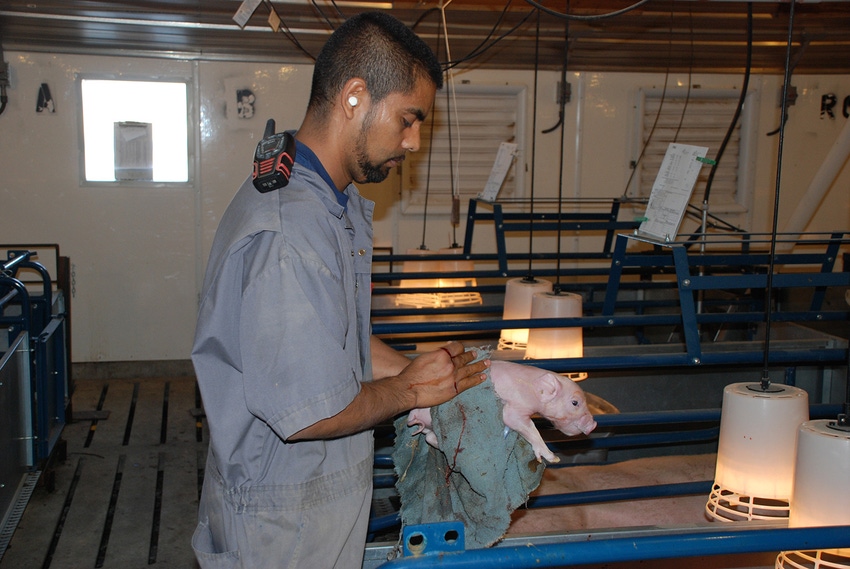Traits that make successful business leaders translate quite well to making successful swine operations.
March 15, 2017

By Daryl Timmerman, AgStar Financial Services
Anyone who still raises hogs has proven their ability to manage through both good and challenging times. From 2008-10, pig farmers were humbled by record losses that were the result of high feed costs and low market hog prices in the shadow of “swine flu” and large hog supplies. The year 2014, while much more profitable for most producers, re-emphasized the importance of biosecurity and tested the abilities of farmers across the United States to be nimble as they implemented action plans in the wake of porcine epidemic diarrhea virus.
When meeting with pig farmers, we are commonly asked, “What are the top producers doing that has enabled them to stand out from the crowd?” When posed this question, I am reminded of Patrick Lencioni’s book, The Ideal Team Player. While Lencioni focuses on the common traits of an ideal team player needed to build a solid employee base, his traits of “smart,” “hungry” and “humble” are closely correlated to what we commonly see in successful swine operations.
They are smart
While intelligence is important, what Lencioni is referring to is being “People Smart.” Over the past 30 years, labor efforts within the swine industry have been routed away from manure handling with pitch forks and feeding sows with buckets. These labor efforts have been re-deployed into added direct care of piglets and herd health oversight that has driven considerable improvement in weaning rates and grow-finish performance. These hands-on animal husbandry efforts are more difficult to replace with equipment.
As such, it is ever more important for owners, their family and their team members to communicate effectively. Unifying the group around goals, providing constructive feedback and empowering the team to take ownership of their respective area are easier said than done. While providing direction is important, top producers spend just as much time listening to the needs of the team and making sure their team is positioned with the resources to succeed.
Being “People Smart” stretches beyond the internal team and out to third-party vendors and key packer relations as successful operations have worked to negotiate terms that are a win-win for all parties involved in each situation. Negotiations can be viewed as a ruthless endeavor; however, our observations are that while short-term gains can be captured, long-term strategic relationships are fostered by parties who maintain a high focus on their approach to engaging with others.
They are humble
Successful producers have high expectations of their team and they are quick to highlight the successes of their team. While this may not sound humble, it is the team recognition, not that of any one individual that instills humility. Lencioni notes “They (great leaders) share credit, emphasize team over self and define success collectively rather than individually.”
Being humble shouldn’t be confused with apprehension or a lack of confidence. Successful producers are visionary, bold in their decision making and swift in implementing key initiatives or risk management strategies. They minimize focus around leadership’s status and excessive egos within their team.
They are hungry
Lencioni writes that “Hungry people are always looking to do more. More things to do. More to learn. More responsibility to take on.”
When thinking about the extremely successful pig farmers that we have the privilege of working with, I feel that the same is true. Top producers are looking for ways to drive continuous improvement throughout their entire system. This hunger is at the core of their DNA as they have built a culture across their farming operations that not only the owners embrace, but also their relatives and hired team members.
Hungry producers were the first to reach a sow performance of 30 pigs weaned per sow per year. They manage by the numbers and are continuously looking for ways to enhance efficiencies while capitalizing on cost-saving opportunities at every turn. Managing details around gilt backgrounding, breeding techniques, diet formulation, Day 1 piglet care protocol and a focus on herd health management are not static. These are reviewed regularly with the team at the sow unit as they look for ways to capture untapped opportunity.
The same holds true in the finishing phase as top producers update diet formulations, settings for barn temperature and ventilation, and target sale weights. It is the core value of continuous improvement that drives hungry, successful producers to further minimize death and sort loss, while maximizing feed conversion and the percentage of pigs marketed to primary markets year over year.
Incorporating all three traits into daily management and long-term culture further separates the top performers. It isn’t just one or two of these traits that drive performance, but the exhibition of all three that correlates with heightened success. We are entering a new era with added packing plant capacity which has stimulated growth across the U.S sow herd. Being hungry, humble and smart will remain important to driving superior operational and financial performance. Farms will need to navigate growing labor dynamics while the industry finds a home for record large pork supplies.
Lencioni, P. (2016). The ideal team player: how to recognize and cultivate the three essential virtues: a leadership fable. Hoboken, NJ: Jossey-Bass, a Wiley Brand.
•••
Timmerman is a senior financial services executive for AgStar Financial Services. For more insights from Timmerman and the AgStar Swine Team, visit AgStarEdge.com.
You May Also Like



